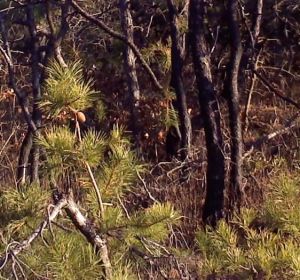When my husband went to school in the area, it was fantasized that the dwarf pines were genetically changed by the exhaust from the “spaceships” that landed there. There seemed to be no other plausible explanation. DNA testing was still in its infancy in the 70’s and the alien landings made sense to college students experimenting with a few plants themselves.
I have been fascinated by these little trees for a long time and I looked up some information on them. Dwarf Pine Plain communities are rare ecosystems that exist in only a few locations in the entire world. The New Jersey Dwarf Pine Plains, the Shawangunk Mountains Dwarf Pine Plains near the Catskill Region of New York, and the Long Island Dwarf Pine Plains are three existing communities in eastern United States. These little trees don’t look like a shorter version of the tall majestic pines surrounding this small area where they have a toehold. The dwarf pines are gnarled and twisted, somewhat irregular in shape. No one could mistake them for a pretty Christmas tree.
About three years ago a wild fire that was started by a misfired flare from a nearby army base burned through 18,000 acres of pine forest including a good portion of the dwarf pines. I remember seeing the complete destruction and utter desecration of those little trees. It looked like the landscape from a horror film. The earth was coal-black burnt undergrowth with the forest reduced to burnt tree skeletons in shapes resembling bodies frozen in torture. I had nightmares for weeks afterwards. What I didn’t know was that the dwarf pitch pines have serotinous cones that are covered with a resin that must be melted by fire to open and release their seeds. In this way they are more fire-adapted than their taller cousins whose cones open when it matures. This special adaptation to fire also gives the dwarf pines their twisted appearance.
Within a month, there was new growth on many of the seemingly dead trees and wildflowers poking through the black ash. Seeing the regeneration of the dwarf pines is enough to make me believe in miracles.
Thank you to the Long Island Trail Lovers Coalition and South Shore Estuary Reserve Council for the information on their websites about the dwarf pines. Thank you also to the off duty State Trooper who, seeing the Fe pulled over with its hazard lights on, stopped to check on us as I took photos.


Leave a comment